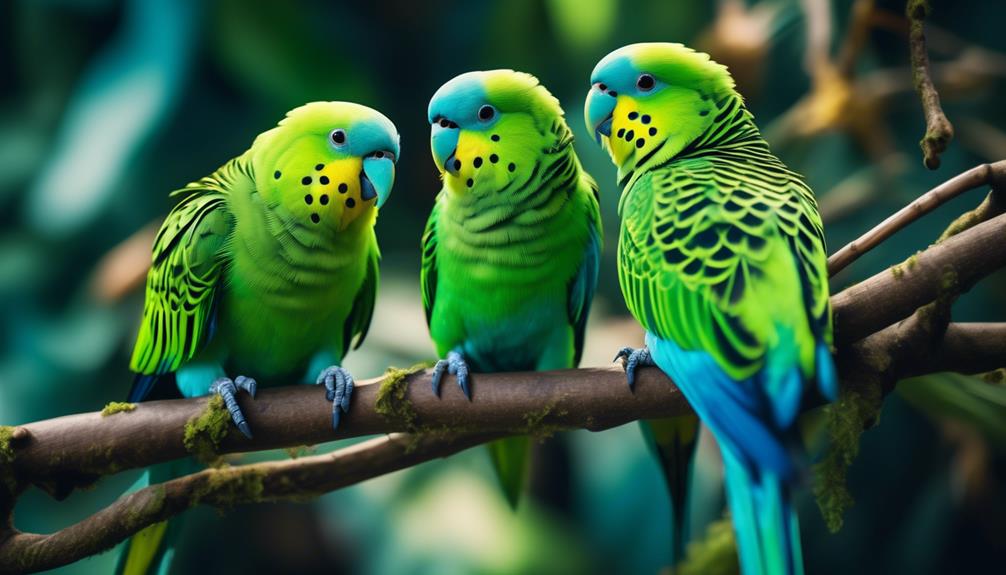
They say that good things come in small packages, and the world of lineolated parakeets is a perfect testament to that. With their vibrant plumage, charming personality, and compact size, these little parrots have stolen the hearts of many bird enthusiasts.
But there’s so much more to discover about these captivating creatures. From their fascinating lifespan to their unique behaviors and the mesmerizing sounds they make, there’s a whole world waiting to be explored.
So, buckle up and get ready to embark on a journey into the captivating world of lineolated parakeets.
Key Takeaways
- Lineolated Parakeets are small-sized parrots, making them suitable for bird enthusiasts with limited living space.
- They have an average lifespan of 10-15 years, but proper care and nutrition can contribute to a longer lifespan.
- Lineolated Parakeets come in various colors, including green, blue, and gray, and may exhibit color variations as they age or during breeding seasons.
- These birds have a gentle temperament, are sociable, and can be trained to perform tricks and mimic sounds.
Size and Lifespan
Lineolated Parakeets are small-sized parrots with a compact and lightweight body structure, measuring approximately 6 inches in length. They’re considered an ideal choice for bird enthusiasts who prefer smaller living spaces. Due to their size, they’re easy to handle and transport.
These parakeets have an average lifespan of 10-15 years, but with proper care and nutrition, they may live even longer. The lifespan of a Lineolated Parakeet can be influenced by genetics and environment, so regular veterinary check-ups are essential to ensure a healthy lifespan. Adequate exercise and mental stimulation also contribute to their longevity.
With their small size and impressive lifespan, Lineolated Parakeets make charming and long-lasting companions for bird lovers.
Bird Species

With their small size and impressive lifespan, Lineolated Parakeets have captivated bird enthusiasts worldwide. Belonging to the parakeet family, these captivating birds are scientifically known as Bolborhynchus lineola. Native to South America, Lineolated Parakeets are part of the Psittacidae family and share characteristics with other parakeet species.
They measure approximately 6 inches in length, making them a small-sized parrot with a compact and lightweight body structure. This makes them easy to handle and transport, as well as fitting well in smaller living spaces. Lineolated Parakeets are available in various colors, including green, blue, and gray, with some color mutations such as lutino and cinnamon.
They communicate through soft chirps and whistles and have natural singing abilities, with vocalizations that may vary among individuals.
Colors

The Lineolated Parakeet exhibits various colors, including commonly seen shades of green, blue, and gray. These colors are the most prevalent in the species and can be found in the wild as well as in captive-bred individuals. However, there are also color mutations that exist within the Lineolated Parakeet population.
These mutations can result in different color patterns, such as lutino and cinnamon. These variations in color add to the captivating beauty of these birds. It’s important to note that the feather coloration of Lineolated Parakeets may change as they age or during breeding seasons. This adds to the uniqueness and individuality of each bird.
Sounds
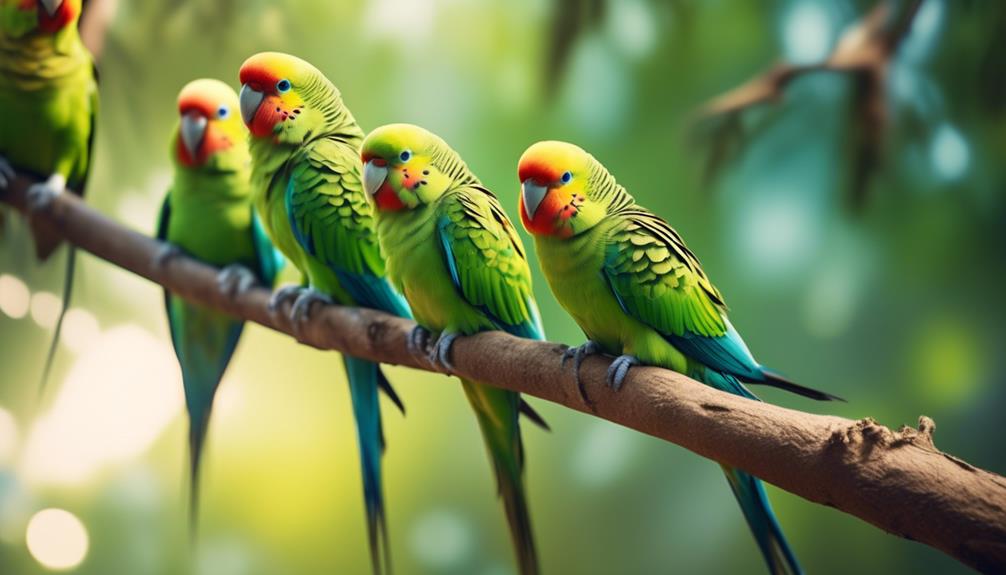
Lineolated Parakeets are generally quiet birds, but they possess the natural ability to mimic sounds and even words. These small parrots are capable of producing a variety of vocalizations, which may vary among individuals. They communicate through soft chirps and whistles, using their natural singing abilities to express themselves. Lineolated Parakeets have the potential to imitate sounds from their environment, such as household noises or the songs of other birds. Some individuals have even been known to learn simple words and phrases. Here is a table showcasing the sounds that Lineolated Parakeets can mimic:
| Sounds they can mimic |
|---|
| Household noises |
| Songs of other birds |
| Whistling |
| Simple words and phrases |
Their ability to mimic sounds adds an extra layer of fascination to these captivating birds.
Diet and Nutrition

Lineolated Parakeets require a balanced diet to maintain their overall health and well-being. These small-sized parrots should be provided with a variety of fresh fruits, vegetables, and high-quality pellets. Their diet should consist of about 60% pellets, 30% vegetables, and 10% fruits.
It’s important to avoid feeding them avocado, chocolate, caffeine, alcohol, and sugary or salty foods, as these can be harmful to their health. Lineolated Parakeets also need access to clean, fresh water at all times. Additionally, they enjoy occasional treats like millet sprays or small amounts of seeds.
It’s recommended to consult with a veterinarian or avian specialist to ensure that the bird’s nutritional needs are being met. Proper diet and nutrition play a crucial role in promoting the bird’s longevity and overall well-being.
Housing and Environment
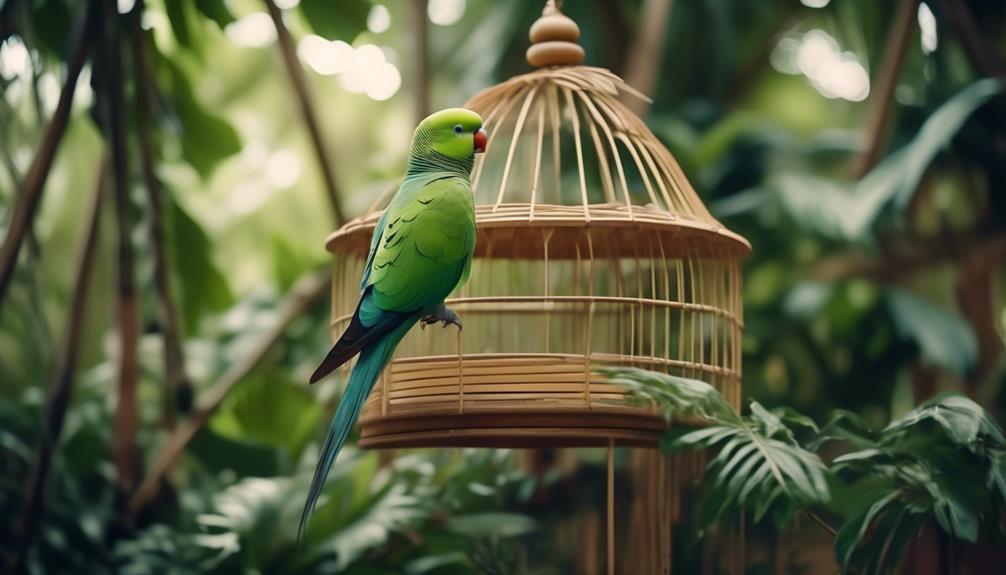
After ensuring a balanced diet for Lineolated Parakeets, it’s important to provide them with suitable housing and an appropriate environment. Here are some key considerations for housing and environment:
- Cage size: Lineolated Parakeets should have a spacious cage that allows them to move around comfortably and stretch their wings.
- Cage placement: The cage should be placed in a quiet area away from drafts, direct sunlight, and other pets or loud noises.
- Perches and toys: Provide a variety of perches and toys to keep the parakeets mentally stimulated and physically active.
- Temperature and humidity: Lineolated Parakeets thrive in temperatures between 65-80°F (18-27°C) and moderate humidity levels.
- Safety precautions: Ensure the cage has secure latches, avoid using toxic materials, and regularly inspect for any potential hazards.
Behavior and Temperament

Lineolated Parakeets exhibit fascinating behaviors and have a gentle and affectionate temperament. These birds are known for their playful nature and ability to form strong bonds with their owners. They enjoy socializing and interacting with their human companions, often seeking attention and affection. Lineolated Parakeets are also highly intelligent and can be trained to perform tricks and mimic sounds. Despite their small size, they are not timid and can be quite bold and curious. They are generally peaceful and get along well with other birds, making them ideal pets for those looking for a friendly and sociable companion. Here is a table that summarizes the behavior and temperament of Lineolated Parakeets:
| Behavior | Temperament |
|---|---|
| Playful | Gentle |
| Affectionate | Curious |
| Intelligent | Sociable |
| Bold | Peaceful |
| Trainable | Friendly |
Training and Enrichment
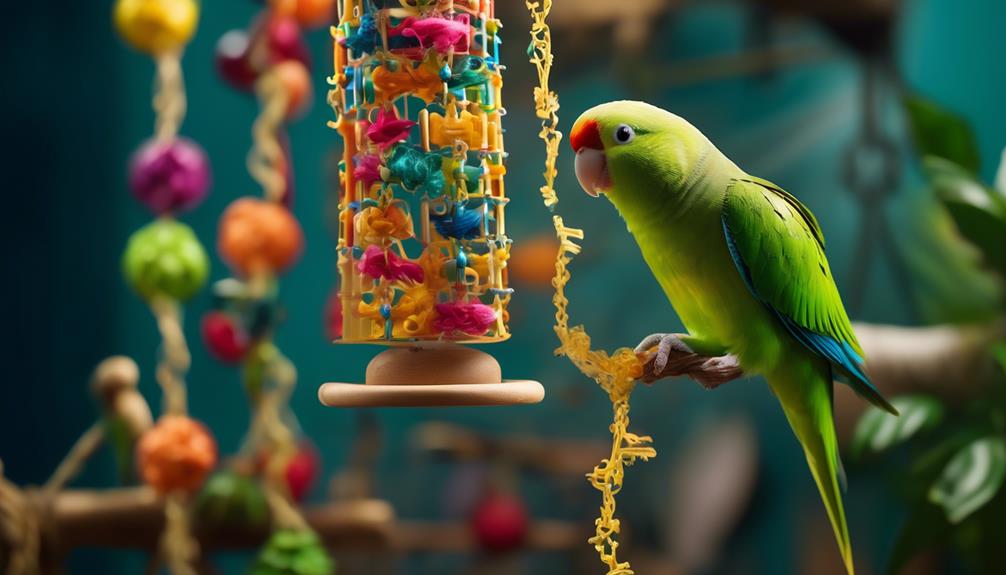
To effectively train and enrich Lineolated Parakeets, owners can implement a variety of interactive activities and provide stimulating environments. Here are some ways to ensure the mental and physical well-being of these captivating birds:
- Clicker training: Use positive reinforcement techniques, such as clicker training, to teach tricks and commands.
- Puzzle toys: Provide puzzle toys that require problem-solving skills, encouraging mental stimulation.
- Foraging activities: Hide treats or food in different areas of their enclosure to simulate natural foraging behavior.
- Social interaction: Lineolated Parakeets are social birds, so spending quality time with them and providing opportunities for socialization is essential.
- Environmental enrichment: Add perches, swings, and climbing structures to their cage to promote exercise and physical activity.
Care and Health Maintenance
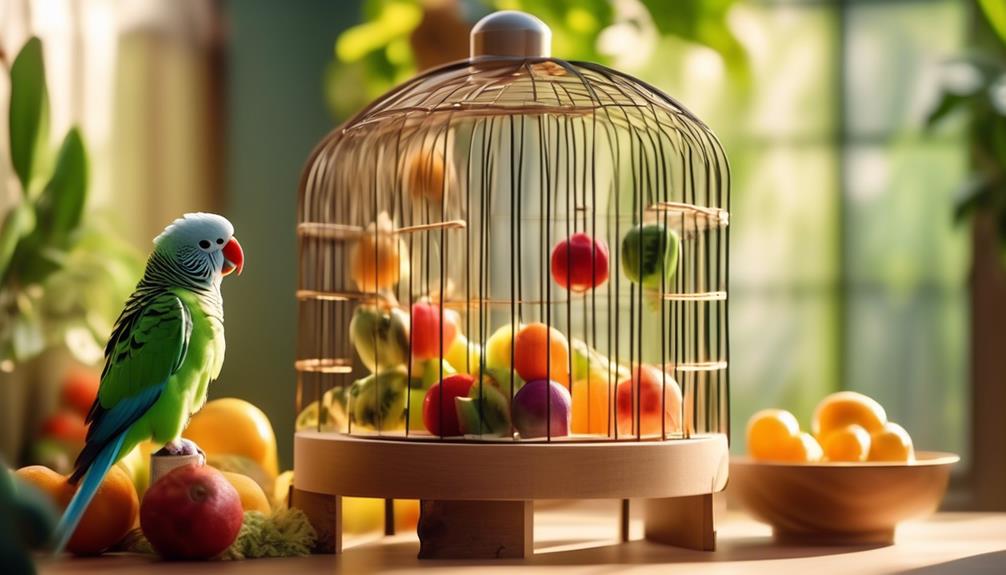
Regular care and maintenance are crucial for ensuring the health and well-being of Lineolated Parakeets. These small-sized parrots, measuring approximately 6 inches in length, require proper attention to thrive.
One important aspect of care is providing a well-balanced diet consisting of fresh fruits, vegetables, high-quality pellets, and occasional treats.
Lineolated Parakeets also need a clean and spacious cage, with perches and toys for mental stimulation and exercise. Regular cleaning of the cage and providing fresh water are essential for their health.
Additionally, it’s recommended to schedule regular veterinary check-ups to monitor their overall well-being and address any potential health concerns.
Frequently Asked Questions
Can Lineolated Parakeets Be Trained to Talk and Mimic Sounds Like Other Parrot Species?
Lineolated parakeets, like other parrot species, can be trained to talk and mimic sounds. They have natural singing abilities and can communicate through soft chirps and whistles. Their vocalizations may vary among individuals.
What Is the Average Weight of a Lineolated Parakeet?
The average weight of a lineolated parakeet is approximately 50-65 grams. They are considered small-sized parrots with a compact and lightweight body structure, making them easy to handle and transport.
Are Lineolated Parakeets Prone to Any Specific Health Issues or Diseases?
Lineolated parakeets are generally healthy birds, but they can be prone to certain health issues. Regular veterinary check-ups, proper nutrition, and a stimulating environment can help prevent diseases and ensure a long, healthy life.
How Long Does It Take for a Lineolated Parakeet to Reach Its Full Adult Size?
A lineolated parakeet takes about 12-18 months to reach its full adult size. During this time, it goes through various growth stages, with its body gradually maturing and reaching its final size.
Can Lineolated Parakeets Live With Other Bird Species in the Same Cage?
Lineolated parakeets can typically live with other bird species in the same cage, as long as they are compatible and their needs are met. However, it’s important to introduce them gradually and monitor their interactions for any signs of aggression or stress.
Are Lineolated Parakeets and Alexandrine Parakeets Similar in Care and Behavior?
Both Lineolated parakeets and Alexandrine parakeets require similar care and have similar behaviors. Both species enjoy social interaction, regular exercise, and a nutritious diet. However, it’s important to discover the colorful Alexandrine parakeet‘s specific needs to ensure they thrive in a home environment.
Conclusion
In conclusion, lineolated parakeets are fascinating birds with a captivating world to discover.
From their compact size and long lifespan to their vibrant colors and unique sounds, they’re truly a delight for bird enthusiasts.
With proper care and nutrition, these charming parakeets can bring joy and companionship for many years.
Whether you’re interested in their behavior, training, or health maintenance, lineolated parakeets have so much to offer as pets.
So, dive into their captivating world and enjoy the wonders of these beautiful birds.




